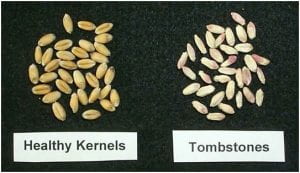Bob Mulrooney, Extension Plant Pathologist; bobmul@udel.edu
Soybeans
The dry conditions combined with high soybean cyst nematode (SCN) egg counts could mean we will see more stunting from SCN this season. Be on the lookout for stunting in irregular areas. The SCN females can be seen on the roots of infected soybeans around 28-32 days after planting.
Barley
Barley harvest is fast approaching and the crop looks pretty good. Besides some leaf rust, net blotch, powdery mildew on ‘Thoroughbred’, and a little head scab, diseases have not been bad this season.
Wheat
A few diseases were observed during a recent check of the variety plots near Middletown in New Castle County. Low levels of tan spot and powdery mildew were seen in a few varieties, but all but one of the 45 entries had some head scab. Most of the infections were under 1% of the heads infected and many of those heads were only partially infected. Wheat in NCC was the most at risk according to the scab predictions. Some shriveled grain with the white coating of the Fusarium fungus was observed on some of the infected heads. Increasing fan speed on the combine will blow the light chaffy “tombstones” out the back and not contaminate the rest. Planting multiple wheat varieties with different flowering times (maturity) will decrease the risk of scab for next year. Statewide, overall scab levels are low compared to several years ago. I had mentioned in last week’s WCU that several varieties in the variety trial had genetic flecking or a resistance reaction including Merl, USG 3209, USG 3251, USG3665, Sunburst, and Grow Mark FS627. These symptoms are not an active disease.
Flecking on USG3409 that looks like a disease
Head scab on wheat
Healthy kernels and Fusarium head scab infected “tombstones”
Tan spot on wheat
Harvesting Grain from Scabby Fields
The following are tips to reduce the amount of scabby kernels in the harvested grain and to avoid potential health problems for combine operators and grain handlers. Scabby grain is contaminated with mycotoxins, especially vomitoxin, which is harmful to humans.
Harvest tips:
1. Avoid breathing in dust from scabby fields by using a high quality dust mask. Spores of the scab fungus (Fusarium graminearum) and small pieces of contaminated plant parts are present in the dust. Inhaling these particles may cause health problems.
2. Harvest the most severely scab damaged areas, such as low areas or double seeded headlands, separately. Don’t co-mingle the most damaged grain with sounder grain.
3. Turn up the air on the combine to blow out the lightest, scabby kernels back into the field.
4. If rain is forecast, it may be better to harvest scabby fields at slightly higher moisture content than to wait for grain to dry down. However, this grain still needs to be dried down and maintained below 15% moisture after harvest to prevent fungal growth in storage.
5. After harvest, gravity table grain separation can be used in removing more of the light-weight, scabby kernels.
6. Get grain from scabby fields tested for vomitoxin before feeding, before blending, or before making a decision to discard suspect grain.
From http://www.scabsmart.org/harvest%20practices.html




